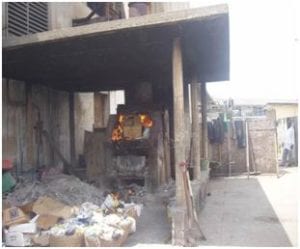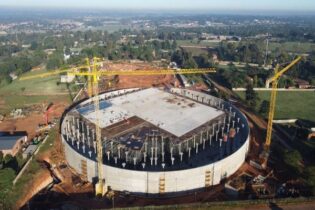Pictured: A locally built incinerator at a health-care facility, Ibadan, Nigeria
In Western Africa, the rapid rate of uncontrolled and unplanned urbanisation coupled with a high density of urban settlement and changing consumption patterns, have accelerated the need for water supply, sanitation and waste management infrastructure – often resulting in no proper separation of the different health care waste as well. This is the fourth instalment of four parts of a paper investigating waste management and its challenges in the west of the African continent and deals specifically with the handling of health-care waste in the region before drawing the final conclusions. Health-care waste Often, no proper separation of the different types of health-care waste takes place, resulting in it getting mixed with household waste. Very few institutions separate their waste, predominantly large hospitals in major cities. They separate sharp waste; infectious, but not sharp waste; and anatomical waste; sometimes using a colour code system. In the healthcare institutions, waste is most often not transported adequately (containers without wheels, etc). Infectious waste is sometimes treated with bleach, sterilised in autoclaves or incinerated. But most health-care facilities do not have access to such treatment facilities, and if they exist, they are often dysfunctional (open-air incinerators) or out of operation. The most modern incinerators in Senegal are to be found in the principal hospital –the Dantec Hospital and in the Pasteur Institute. Ash is put together with household waste and brought to the dumping sites. Anatomic waste such as placentas is often delivered to the belonging families for burial. Besides the few treatment options, most of the health-care waste transportation is subcontracted to the same companies that transport municipal solid waste (MSW). Consequently, it ends up at official or informal dumpsites together with the MSW without any prior treatment except in Lagos where the waste is shredded and the original volume is reduced by 80%. The shredded waste is heated at temperature of 1350C and 4 bar pressure. The final products are then disposed of with other general waste (LAWMA, 2008). Some structures such as the University Hospital of Yopougon (Ivory Coast) have their own dumpsite for the reception of wastes of all types. A factory in Port Harcourt, River State (Nigeria) called BOSKEL Thermal Factory incinerates expired pharmaceutical products and antiretroviral drugs in a high temperature rotary kiln incineration (Iyortim et al., 2011).Conclusions
Municipal solid waste is composed of recyclable materials such as organic matter, plastic, paper, cardboard, metal, glass, textiles, etc., but also toxic materials such as car batteries, dry batteries from electronic devices, electronic components, pharmaceutical products and agrochemicals. In Ivory Coast, Ghana, Nigeria and Senegal, sorting at household level is conducted by informal waste buyerswho collect valuable fractions directly from households, small businesses etc. The rest is disposed of as mixed waste. The formal collection theoretically is well organised and includes both door-to-door collection and communal collection from central points. It is normally carried out by private waste service providers contracted by local authorities. In practice, however, the formal collection reveals some difficulties due to service providers that do not attend to their duties, inefficiency of operations, bad road and weather conditions, old vehicles etc. Sorting and recycling of MSW fractions in significant quantities only exists in urban areas. Most of the sorting activities take place in the informal sector that is concentrated on the solid waste dumpsites or on specialised scrapyards. Formal recycling comprises metal scrap recycling, plastic recycling, paper and cardboard recycling as well as recycling of organic waste. The formal recyclers often receive their material from the informal sector. Although sorting and recycling activities are only driven by economic interests, they still contribute to generating secondary resources and therefore conserve primary (natural) resources. However, not much attention is paid to negative environmental impacts during sorting and recycling processes and information on recycling technologies, environmental impacts etc., is rather scarce. MSW is finally disposed of mainly in official dumpsites but also in irregular or illegal dumps. None of the official dumpsites feature leakage water or gas control; leakage water often reaches the closest river or lake. In none of the target countries a sanitary landfill exists where MSW could be disposed of appropriately, although in some countries, such landfills are planned. Instead of dumping MSW, it is a very common practice for households to burn paper and plastic components of their waste. Also, at irregular and official dumpsites, waste is often burnt in order to reduce the volumes. Burning of waste, especially plastics can lead to significant air pollution with dioxins and furans.
Plastic waste, which accounts for around 15 to 20% of municipal waste in the four countries, is rarely sorted at source but disposed of together with the remaining waste fractions. Separate collection is carried out by informal collectors that sort, reuse and recycle plastics themselves or work together with a formal plastic recycler. Both formal and informal plastic recycling exists that include sorting, shredding, washing, drying and extruding in order to produce pellets or flakes. There is little documentation on recycling processes and its resulting environmental impacts. There are plans to intensify sorting and recycling of plastics in some cities. Waste electric and electronic equipment (WEEE) or e-waste originates mainly from households, corporate businesses, public institutions and repair businesses. There is no formal collection of e-waste but, due to its valuable content (iron, aluminum, copper etc.), it is often bought or collected by informal e-waste collectors who go from door to door but also sift through waste bins, visit landfills and other waste dumping grounds to search for e-waste. The quantity of e-waste is difficult to determine due to different product scope of existing studies. Ghana and Nigeria, which have received large quantities of second-hand equipment in the past years, have showed a significantly higher e-waste generation than Ivory Coast and Senegal. Obsolete EEE is often refurbished or repaired before it is disposed of. These activities in general do not lead to negative environmental impacts but contribute to the extension of the lifetime of equipment and therefore a reduction of WEEE generated. Recycling of e-waste mainly takes place at informal scrapyards where devices are manually dismantled and valuable substances are extracted, sorted and then sold to local smelters or exporters. Copper cables are often burnt to remove the plastic casings. ‘Non profitable’ fractions such as plastic casings are not recovered and usually dumped and eventually burnt in order to reduce the volumes of the dumpsites. Besides valuable substances, e-waste also contains many toxic substances (lead, cadmium, mercury, plastics with brominated flame retardants) that are released during the dismantling and burning process and lead to serious environmental impacts. Final disposal of e-waste fractions often takes place on irregular or illegal dumpsites next to the scrapyards. There are no appropriate disposal options for hazardous substances resulting from e-waste recycling in the target countries. Health care waste constitutes a problem in all four target countries. Most often, no proper segregation of health-care waste takes place and it is often mixed with household waste. Very few facilities segregate their waste, mostly large hospitals in major cities. But most health-care facilities do not have access to treatment facilities and, if they exist, they are often dysfunctional or out of operation. Besides the few treatment options, most of the health care waste ends up at official or informal dumpsites together with the municipal waste. In conclusion, solid waste management practices in Western Africa are characterised by a high participation of informal actors, remarkably frequent reuse, sorting and recycling practices (which is particularly remarkable given the absence of support from public bodies to these actors) but also persistent inappropriate practices such as open-air dumping and burning of all types of waste including hazardous waste. A sustainable solution to these challenges could consist in measures for the social and economic inclusion of the informal sector (for collection, reuse, separation and recycling) and for the industrialisation of disposal practices, especially sanitary landfills and treatment plants for hazardous waste. This is an abridged version on the project of Integrated Waste Management in Western Africa. The duration of the project, funded by the EU within the Seventh Framework Programme, was two years and the results of the research were submitted during May 2012. For a full version including references, please contact Chantelle Mattheus at chantelle@3smedia.co.za







